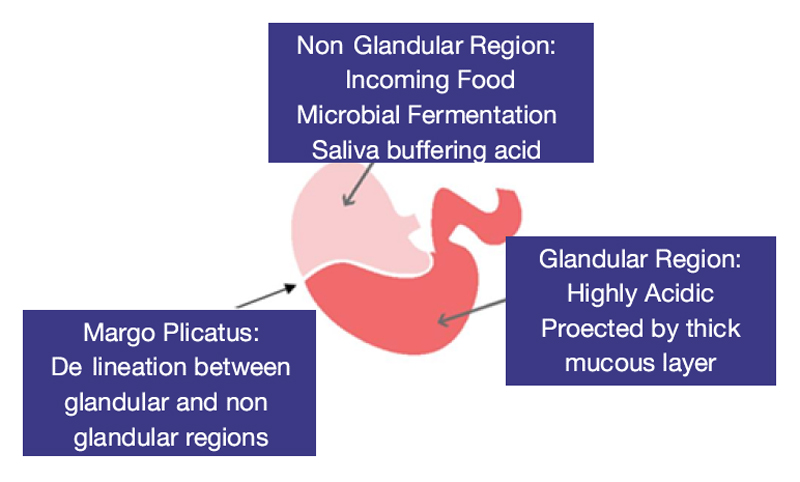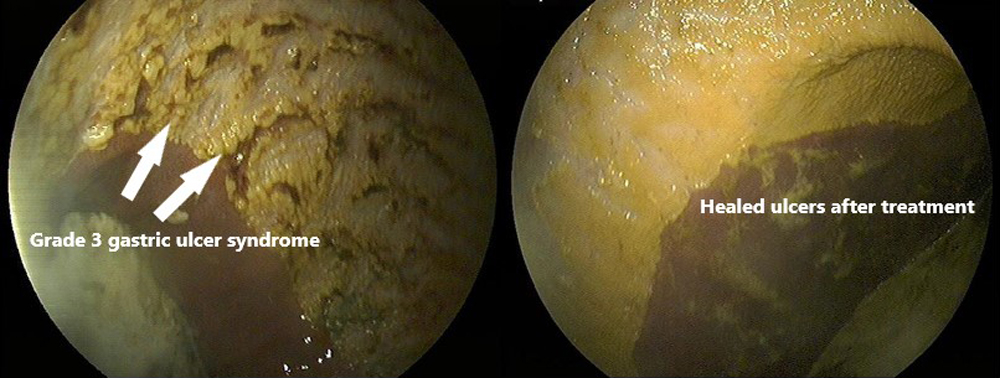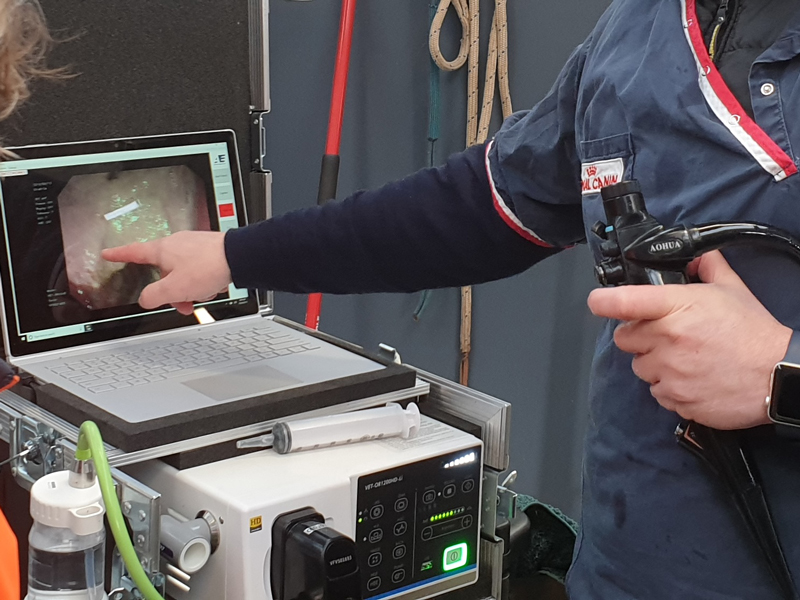Case of the Month
Bella presented to our vets at the end of November as she was showing some of the “typical” outward signs commonly reported with stomach ulcers aka Equine Gastric Ulcer Syndrome (EGUS) including poor quality coat, poor appetite, temperamental behavior when tightening girth and general poor body condition. Bella is a 3yo thoroughbred racehorse that had been in the paddock spelling for several weeks. She had started on ulcer treatment one week prior to the gastroscope (stomach scope) due to the outward signs she was showing.
The Gastroscope Process
To gastroscope a horse there is a process that must be followed in order to obtain the best images we can of the stomach. Firstly, horses must be fasted for no less than 12 hours prior to the scheduled gastroscope. Ideally this means the horse is stabled from the night before the scope. Water must then be removed 4 hours prior to the scope. At the time of the scope we sedate the horse so that the process is as stress free as possible for horses and humans.
We then pass a stomach tube through the horses’ nasal passages and down the oesophagus to the stomach. It is at this point that sometimes we can get a slight nosebleed however this is very short lived and as the horse is sedated does not cause them any stress.
Finally, we pass the video scope through the inside of the stomach tube until we arrive in the horse’s stomach and have video footage of the stomach on our tablet screen for all to see. We can then navigate around the stomach to assess for any issues.
The owner’s success at fasting the horse becomes obvious when we arrive in the stomach as if they are not fasted correctly visibility can be poor due to the food present.
To get your bearings here’s a quick guide to the horse’s stomach:
Their stomach is divided into two main sections, the non-glandular or squamous section (white) and the acid producing glandular section (red). The white part of the stomach is more sensitive than the red section and becomes ulcerated if the acid produced in the red section of the stomach encounters it. Most ulcers are detected on the border between these two sections as the acid splashes onto the squamous section at this point.

Back to Bella’s stomach…
On arrival into Bella’s stomach it was obvious straight away what we were dealing with. She had extensive ulcers present throughout the squamous (non-acid producing and white) portion of her stomach. This can be seen in the image on the left. It was decided to treat Bella with Omeprazole (Ulcershield or Gastrozol). This drug suppresses the acidity of the gastric acid and therefore reduces the effect of the acid on the sensitive white part of the stomach and gives it a chance to heal.
The medication starts working after the first dose, but maximum suppression occurs 3 to 5 days after starting treatment. A plan was made to treat Bella with omeprazole for 3 months and at that point to rescope her. Omeprazole is a once daily oral paste. An image of the second scope 3 months later is on the right and it is obvious the healing that has taken place. What was also obvious was the improvement in Bella’s coat quality and body condition. The ongoing plan for Bella is to maintain her on the treatment dose of omeprazole while she is in training. In other situations, we could reduce to the dose of omeprazole to a maintenance rate however as racehorses are at higher risk of ulcers, in this case, we decided to maintain the higher dose rate.
Other management changes can be implemented to reduce the risk of ulcers, these include; Feeding oily/wet feed and hay to allow for a smoother passage of food through the stomach. A chaff/hay feed before exercise can also be beneficial. This increases gut fill and creates a barrier of food to stop the acid from splashing onto the white part of the stomach during exercise.
Ongoing monitoring via gastroscopy, of hoses who have had gastric ulcers in the past is recommended to ensure

At Southwest Equine we have our own portable gastroscope so we can perform exams like the one described above whenever and wherever required. We also have scoping days every few months where we do gastroscopes at a reduced price at our clinic. Get in contact if you think your horse may have stomach ulcers or you want to find out more!
A note on Omperazole and Calcium...
Due the mechanism of action of omeprazole in the stomach there has been recent studies done to test whether its use in horses effects the uptake of calcium from their diet. One study in Kentucky showed that there was a slight reduction in calcium absorption when horses were on omeprazole. However, it is worth noting that most horse diets are formulated with calcium in excess of daily nutritional requirements and it is doubtful that the small decrease in digestibility that was observed would put horses receiving practical diets in a deficient state. Another study on standardbreds which used x-rays of the cannon bone before and after 8 weeks of treatment with omeprazole showed no negative effect to the skeletal health markers they assessed in the study. Horses with a history of any heart problems such as Atrial Fibrillation could potentially be affected by a calcium deficiency as calcium is required by the heart muscles to maintain its rhythm. Even though there is no evidence to prove this in horses it is still worth being mindful of this when having horses on omeprazole long term. Excess dietary calcium can also cause heart abnormalities so supplementing with excess calcium is probably not the answer either! There does need to be more research done in this area over longer periods of time before we can be confident of the potential secondary problems of having horses on ulcer treatment. In the meantime, if there are any doubts over horses on omeprazole being deficient in calcium, we can do further testing on urine to assess calcium levels.

